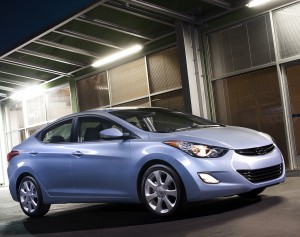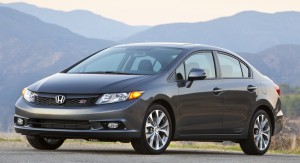When automakers close the books on 2011 tomorrow, they’re expected to not only show a moderate gain of about 10% for the year but, more importantly, provide a clear indication that car sales are on an upswing.
Housing sales may still be struggling and the jobs market still in the doldrums but two years after the worst automotive downturn since the Great Depression the cash registers are ringing loud at the nation’s car dealers. Most forecasters now see demand surging from about 12.7 million vehicles this year to anywhere from 13.8 to more than 14 million for 2012.
And the trendline is pointing in the right direction in almost every major market worldwide, suggests a new study by the Detroit-based research firm Polk. Its new global automotive forecast foresees worldwide sales of 77.7 million vehicles in 2012, a 6.7% jump from last year.
“We’ve been recovering a lot faster than many people expected just two years ago,” says automotive analyst Joe Phillippi, of AutoTrends Consulting.
It was anyone’s guess how low things could go when the recession struck, sales plunging to just 10.4 million in 2009, almost 40% off the peak set the previous decade. Sales rose to 11.5 million in 2010 and are expected to come in at 12.7 million once the final figures for 2011 are tallied.
That was short of the 13 million target many experts had been eagerly eyeing earlier in the year. But then the market was slammed by a variety of factors including soaring fuel prices, a plunge in consumer confidence and signs that the overall economy might slip into a double-dip recession. Meanwhile, a March 11 earthquake and tsunami all but shut down the Japanese auto industry, makers like Toyota and Honda spending months struggling to ramp production back up.
But despite growing pessimism, auto sales regained unexpected momentum during the final months of the year. November saw demand reach the highest monthly level since the Cash-for-Clunkers program of 2009. Preliminary estimates anticipate December’s sales will come in at an annualized rate of 13.4 million. Though that would be slightly behind November’s numbers that’s no surprise considering shoppers normally focus on other purchases in December.
So, where will 2012 wind up? Gun-shy prognosticators are largely erring on the cautious side and most are laying out forecasts of around 13.8 million, but some believe the market could surge to 14 million – normally considered a “healthy” level – or even higher.
A variety of factors will likely influence where things go. There is, for one thing, a lot of pent-up demand, suggests Phillippi. Many potential buyers have delayed trading in with their own job and economic situations so uncertain. There is little doubt that the burst in sales during the final quarter of 2011 was fueled by so-called “pent-up demand,” as many of those buyers finally decided to risk getting back into the auto market.
There are millions more American motorists who would have bought new vehicles over the last few years were it not for the recession, says Phillippi, and “the industry could benefit, again, from that pent-up demand this year,” he adds, before quickly cautioning that “the question is what they will buy?”
This past year saw a strong surge in used car sales – which drove the price of “previously owned” vehicles to record levels. Will cautious shoppers trade in on used vehicles or return to the new car market in 2012?
The answer to that question could depend on how aggressive manufacturers become when it comes to incentives. The industry, on the whole, actually trimmed back on givebacks, last year. But some observers fear we could be ready for a profit-slashing rebate war. But where in the past that might have been triggered by Detroit’s Big Three, this time it could be the Japanese who start plopping money on the hood.
There’s little doubt the Japanese were the big losers of 2011, especially Toyota and Honda. The former maker lost 2.5 points of market share, the latter 1.5 points – even as all three of the domestics were up for the first time since 1998, collectively increasing their share from 45.1% at the end of 2010 to about 47% for all of 2011.
The Japanese are largely over the impact of the March disaster and last autumn’s flooding in Thailand. And they’re anxious to regain lost ground, Toyota, in particular, already offering some of the biggest incentives ever from a major Japanese manufacturer.
But it’s no longer a Detroit-Japan battle. The Koreans, Hyundai and Kia, posted some of the biggest gains of 2011, and they’re not about to settle back.
“The momentum has slipped away from the Japanese,” says David Sullivan, an auto analyst with AutoPacific, Inc, who adds, “This is the year the Japanese have finally decided to take the Koreans seriously,” recognizing that many buyers who won’t even consider a Detroit product will look at something from another Asian manufacturer.
Then there’s the German maker Volkswagen, which finally recognized it needed to be a little bit more American to regain the sort of grip it had in the days when the original Beetle was the top-selling import. VW not only launched the third-generation Beetle, last year, but also an all-new Passat which was both roomier and – perhaps more importantly – far less expensive. Analysts now seem more willing to believe VW can actually achieve its goal of more than doubling U.S. sales by 2018.
While fuel prices fell back after the spring 2011 surge, there are signs Americans will experience more pain at the gas pump as the economy recovers. That will likely have significant impact on market trends in 2012.
As TheDetroitBureau.com reports, electric vehicles didn’t quite achieve the results manufacturers – and government regulators – had hoped for in 2011. So, with a flood of new models coming this year, 2012 could be the test of the technology. (Click Here for the full story.)
As analyst Sullivan points out, electric powertrain technology is getting a surprisingly stiff run for the money as industry engineers find ways to squeeze far better mileage out of the century-old internal combustion engine.
Perhaps one of the biggest surprises of the past year was delivered by Ford Motor Co., which saw more than half of the F-150 pickups it built purchased with V-6 engines, rather than the beefy – if far less fuel-efficient — V-8s truck buyers normally favor.
While there’s also been a moderate amount of downsizing, Americans have not switched, en masse, to compacts and subcompacts, and improved gas and diesel engine technology may be a major reason why not.
The U.S. market appears to have delivered another surprise by actually growing faster than China’s, the first time that has happened in nearly a decade. That’s not likely to continue in 2012, predicts the new Polk study. It foresees single-digit gains in the States and a 16% jump in China.
Polk projects the growth in worldwide vehicle demand is now back on track and that sales should surge to 77.7 million before the books are closed on this new year. In fact, it anticipates sales will grow in virtually every market – with the exception of Europe. There, demand is likely to be flat or even decline a bit.
Other analysts have come to a similar conclusion. They also warn that with Europe’s debt crisis far from resolved that poses a significant risk for much of the rest of the world. So, while 2012 has a good chance of being a year of recovery there are plenty of uncertainties that remain, like a Sword of Damocles, hanging over the head of the worldwide auto industry.


